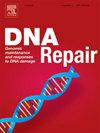RAD51 激化化合物对 HR 的短暂增强可保护小鼠肠道组织而非造血组织免受辐照。
IF 2.7
3区 生物学
Q2 GENETICS & HEREDITY
引用次数: 0
摘要
DNA双链断裂(DSB)是一种细胞毒性损伤,会损害基因组的完整性并引发细胞死亡。同源重组(HR)是修复循环细胞中DSB的主要途径。然而,瞬时调节HR是否能保护成体干细胞免受致命辐照照射,目前仍不清楚。在这项研究中,我们研究了RAD51刺激化合物RS-1对肠道和造血组织中不同循环速率的成体干细胞和祖细胞的放射保护作用。即使使用高剂量的RS-1,在体内也不会引起肠隐窝细胞明显的细胞死亡或增殖。辐照前用RS-1预处理可显著减少有丝分裂死亡,促进DNA修复,提高肠道干细胞和祖细胞的存活率,增加隐窝再生集落的数量,从而减轻红外诱导的胃肠道综合征。此外,RS-1预处理可提高体外辐照肠组织细胞的存活率和再生率,RAD51抑制剂可挽救这种情况。然而,在体内用RS-1预处理并不能提高6 Gy辐照后骨髓中的有核细胞数或HSPCs。此外,药物治疗也没有影响小鼠的存活率。因此,我们的数据表明,以HR为靶点作为防止急性辐照造成组织损伤的策略可能取决于细胞循环率和内在DNA修复机制。本文章由计算机程序翻译,如有差异,请以英文原文为准。
Transient HR enhancement by RAD51-stimulatory compound confers protection on intestinal rather than hematopoietic tissue against irradiation in mice
DNA double-strand breaks (DSBs) are cytotoxic lesions that compromise genomic integrity and trigger cell death. Homologous recombination (HR) is a major pathway for repairing DSBs in cycling cells. However, it remains unclear whether transient modulation of HR could confer protection to adult stem cells against lethal irradiation exposure. In this study, we investigated the radio-protective effect of the RAD51-stimulatory compound RS-1 on adult stem cells and progenitor cells with varying cycling rates in intestinal and hematopoietic tissues. Treatment with RS-1 even at high doses did not induce noticeable cell death or proliferation of intestinal crypt cells in vivo. Pretreatment with RS-1 before irradiation significantly decreased mitotic death, promoted DNA repair and enhanced the survival of intestinal stem cells and progenitor cells and increased the number of regenerative crypt colonies thereby mitigating IR-induced gastrointestinal syndrome. Moreover, RS-1 pretreatment could increase the survival and regeneration of irradiated intestinal organoids in vitro, which can be rescued by RAD51 inhibitor. However, pretreatment with RS-1 in vivo did not elevate nucleated cell count or HSPCs in bone marrow after 6 Gy irradiation. Additionally, there was no impact on mouse survival due to drug treatment observed. Thus, our data suggest that targeting HR as a strategy to prevent tissue damage from acute irradiation exposure may depend on cell cycling rates and intrinsic DNA repair mechanisms.
求助全文
通过发布文献求助,成功后即可免费获取论文全文。
去求助
来源期刊

DNA Repair
生物-毒理学
CiteScore
7.60
自引率
5.30%
发文量
91
审稿时长
59 days
期刊介绍:
DNA Repair provides a forum for the comprehensive coverage of DNA repair and cellular responses to DNA damage. The journal publishes original observations on genetic, cellular, biochemical, structural and molecular aspects of DNA repair, mutagenesis, cell cycle regulation, apoptosis and other biological responses in cells exposed to genomic insult, as well as their relationship to human disease.
DNA Repair publishes full-length research articles, brief reports on research, and reviews. The journal welcomes articles describing databases, methods and new technologies supporting research on DNA repair and responses to DNA damage. Letters to the Editor, hot topics and classics in DNA repair, historical reflections, book reviews and meeting reports also will be considered for publication.
 求助内容:
求助内容: 应助结果提醒方式:
应助结果提醒方式:


